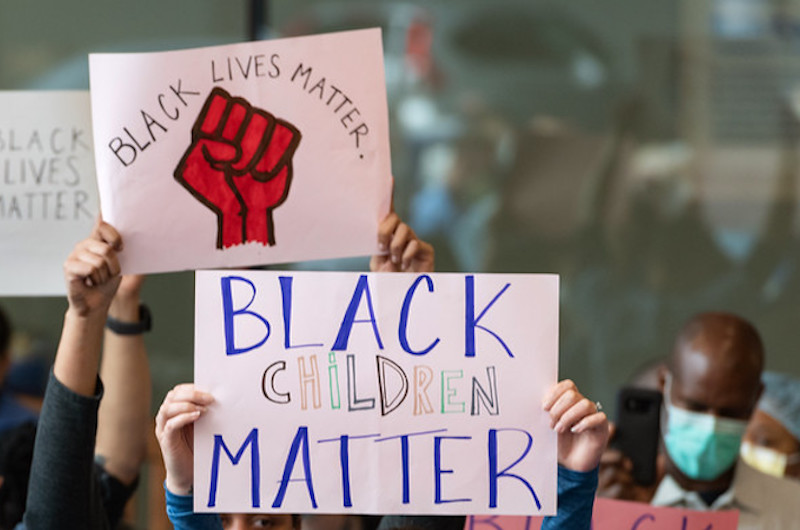Racism and children’s health: What providers need to know

It’s easy to feel outdone by racism, especially as the country cycles through stages of tragedy, awareness, and inertia. But with renewed attention to violence against Black people in recent weeks, many health care providers are asking themselves hard questions:
- Can we create a better world for the next generation?
- Can the call for racial justice lead to sustainable action?
- Can health care be part of the solution?
Yes, yes, and yes, say Keneisha Sinclair-McBride, PhD, and Erica Lee, PhD, attending psychologists at Boston Children’s Hospital. However, getting there will take commitment, work, and a willingness to feel uncomfortable.
Health disparities and other forms of racism in health care
Understanding the problem comes first. “Racism can show up in health care in three key ways,” says Sinclair-McBride, “in the form of health disparities, emotional trauma from experiencing racism, and provider bias.”
The demographics of COVID-19 reflect health disparities that have long affected minority communities. More Black people have tested positive and died from the disease than any other group in the U.S. While COVID-19 largely affects adults, its racial impact reflects other patterns of illness. Children of color have higher rates of asthma, type 2 diabetes, and obesity. Rates of low birthweight are highest for Black children. Black and Latino children are less likely to survive childhood cancer.
“Children of color carry the physical, mental, and emotional burden of living in a society that assigns them less power,” says Lee. “The consequences are tremendous, particularly for our Black and brown children.”
Racism causes emotional trauma
Children experience the emotional trauma of racism in a variety of ways. “Sometimes it’s vicarious, such as when a child sees someone who looks like them being brutalized,” says Sinclair-McBride. The video of George Floyd’s violent death caused vicarious trauma for many Black people.
You can’t control your automatic first thought. But you can control your second thought. You can control the words you say and the actions you take.”
Keneisha Sinclair-McBride
But subtle slights and invalidations can also cause profound suffering. Microaggressions, brief, but common in many children of color’s lives, undermine their dignity, worthiness, and intelligence. The power of microaggressions lies in their frequency and subtlety. “They leave children questioning themselves: ‘Did that really happen? Will they think I’m being too sensitive? Should I say something back?’” says Sinclair-McBride.
Racial bias can undermine provider-patient relationships
Microaggressions can also find their way into patient-provider interactions, even with well-intentioned providers. Sinclair-McBride and Lee sometimes hear from patients who felt hurt or confused by a provider making assumptions about their socioeconomic status, neighborhood, family structure, or interests.
Well-meaning comments on achievements, if they come with hints of shock or surprise, can reinforce an expectation that Black children underachieve. In these instances, the provider may not realize their reaction showed. “But for kids who experience microaggressions all the time, bias can be really obvious,” says Sinclair-McBride.
It all starts with self-examination
Having biases is not inherently wrong. “We all see the world through a cultural lens,” says Lee. But when they go unchecked, biases can undermine trust and reinforce feelings of isolation in children who badly need to connect with an adult who believes in them. “Being a culturally responsive provider requires that we ask ourselves which biases we bring into the room.”
Building an anti-racist health care system, therefore, starts with self-examination. This is where the hard work begins. “No one wants to admit they harbor racial bias,” says Sinclair-McBride. “But we live in a biased world. We all carry the impact of living within this system.”
Showing patients we are open to discussing how racism impacts their lives and relationships, including with providers, validates their experience.”
Erica Lee
Lee adds, “It can be challenging to examine our own discomfort. But if we are uncomfortable around issues of race and identity, our patients will be too.”
Sinclair-McBride has found that colleagues may be worried they can’t control their unconscious thoughts. She agrees — up to a point. “You can’t control your automatic first thought. But you can control your second thought. You can control the words you say and the actions you take.” In other words, by recognizing their personal biases, providers can set conversations on a new course.
How and why to talk about racism with patients
You can’t put a cast on racism and wait for it to heal. Providers can, however, create safe space in which their patients feel free to talk about their experience. For a child taught to doubt themselves through daily microaggressions, this is powerful medicine. A few simple, respectful questions can open up space for children to share their experiences.
Questions that can help create a safe space for patients to talk about racism
- How are you feeling about what’s going on in the world right now?
- Have you ever felt discriminated against?
- Do you have someone you feel comfortable talking to about your experiences?
Some patients may open up. Others may not. “A lot of people of color feel fatigued from always talking about race. They don’t want to feel like they have to be a spokesperson” says Sinclair-McBride. Some patients may want their health care visit to focus mainly on the health problem at hand. But knowing that they can talk openly with their provider if they want to can make a profound difference. “Having a provider who acknowledges that these things are real, that they’re painful and not okay, is huge for a child.”
Lee adds, “Showing patients we are open to discussing how racism impacts their lives and relationships, including with providers, validates their experience. We can create safe spaces, but respect their boundaries and follow their leads.”
Building blocks of anti-racist health care
Patients aren’t the only ones who need to feel safe talking about their experience. At Boston Children’s, clinicians, researchers, and other staff have engaged in open, and sometimes uncomfortable, discussions about how racism colors their personal and professional experiences.
“Living the values of an anti-racist society starts with each of us,” says Lee. “We can commit to the hard conversations, not only in our communities, but also with each other. We can speak up for our colleagues when we witness microaggressions or discrimination.” Strong leadership and individual action are two critical components to equality in the workplace. “Let’s be open to learning, making mistakes, and then doing better,” she says.
Read more on racism from Boston Children’s.
Related Posts :
-

Creating the next generation of mRNA vaccines
During the COVID-19 pandemic, mRNA vaccines came to the rescue, developed in record time and saving lives worldwide. Researchers in ...
-

Firearm suicides in children and youth: A state-by-state look
At a time when mental health problems are skyrocketing, a new study provides one of the most comprehensive state-by-state accountings ...
-

Boosting vaccines for the elderly with ‘hyperactivators’
As we age our immune systems start to flag, leaving us more susceptible to cancer and infections — and less responsive ...
-

Reversing the trend: Easing the mental health boarding crisis in emergency rooms
Anxiety, depression, and suicide attempts have been rising over the past decade, especially among teens, often landing them in emergency ...





